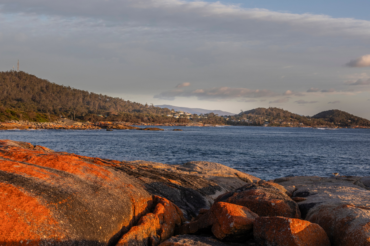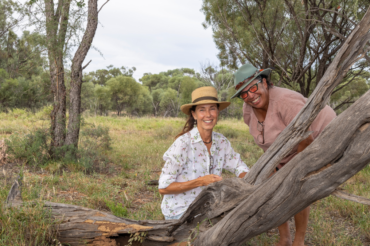
A road-trip along the Pilbara Coast reveals surprises at every turn. It is dawn on ANZAC Day in Onslow, Western Australia and the new sun appears over the Indian Ocean to pierce the war memorial, blazing through the centre of an arch mirroring its rising.
The memorial is built specifically to capture these rays on this day and it is the perfect place to pause and reflect. That such a unique and stunning tribute occurs in this small town of less than 1000 people is typical of the surprises revealed on a 770-kilometre journey, on sealed roads, along the Pilbara coast to Eighty Mile Beach in the north. Not that Onslow’s surprises stop at the war memorial. Like most of the Pilbara it is sustained by mining. Flying into town, in order to collect a hire car from the airport, reveals vast chequered fields of growing salt and the associated dazzling mountains of final product ready for shipping to overseas destinations.
At night, gas plants light the horizon as though a city lives on Onslow’s doorstep. Yet, contrasting with the human construct are the turquoise waters of Beadon Bay where it is possible to watch both sunrise and sunset over the water. Time your visit correctly and you may also see the spectacle that is the Staircase to the Moon, an optical illusion created when moonbeams reflect over the tidal flats. The foreshore is lined with bronze paparazzi dog statues (“the world’s most notorious photographers”) and the Goods Shed Museum offers a fascinating insight to the area’s history (and a homemade submarine). Add to your list the Ashburton River, the relics of Old Onslow and a fishing extravaganza offshore to the Mackerel and Monte Bello Islands and Onslow is a destination on its own. But in the spirit of the road-trip we move on.
It’s a 76km run south along Onslow Road, past paddocks of towering termite mounds, to meet the North West Coastal Highway, and another 214km north to the City of Karratha. This is the administrative heart of the Pilbara and the epicentre of a multitude of extractive industries including salt, gas, iron ore and ammonia, many of which offer tours to those interested. The Burrup Peninsula is home to this high-tech world and on first look the jumbled rust-red rocks look as though they have been dumped by man but this is a natural feature and hidden among the heat-radiating rocks is an ancient world. Murujuga National Park contains what is considered to be the world’s largest collection of aboriginal rock engravings (known as petroglyphs).

Taking a tour with Indigenous guide Clinton Walker will give voice to stories from a different time; stories that explain the presence here of thylacines (Tasmanian tigers) and to beings who form existential foundations. There are also the familiar shapes of kangaroos and emus. Clinton’s Ngurrangga Tours can take you deeper into the Pilbara to discover flat-topped mountains, paperbarklined waterholes and hidden rock holes. Each is brought to life by the stories he tells and, perhaps, by an unexpected and mysterious breeze that welcomes you to country. But back on the Burrup there is one last must-see and this is Hearsons Cove, one of the Pilbara’s favourite swimming spots. On high tide, vibrant blue waters lap the shell beach and their dense salinity allow for easy and relaxing floatation.
It is a short 12km drive from Hearsons Cove to Dampier where sheltered, palm-lined beaches lie beside the busy industry of the port. You can take in the action from the veranda of the Mermaid Hotel or join a charter to one of the 42 secluded islands of the Dampier Archipelago. But don’t leave Dampier without paying your respects to Red Dog, the kelpie made famous in the movie of the same name. He is commemorated in bronze at the town’s entrance. Red Dog wandered throughout the Pilbara in the 1970s, making friends at every turn, and at Roebourne, 40km north of Karratha on the highway, his story continues with vet Dr Rick Fenny who was with him when he passed away.
Rick may even point you to Red Dog’s final resting place near Cossack, 14km away at the mouth of the Harding River. Cossack, itself, is a ghost town from the 1870s with stone buildings standing as testament to our pioneers, but in July each year it comes alive for an art exhibition that is gaining fame throughout the regional Australian art world. While in the area a drive to Point Samson for its equally famous fish and chips is a must before heading back to the highway. Travelling north again and the surprises and contrasts continue. You will pass enormous dry river beds, share the road with quad trucks carrying manganese and view ironore trains up to 2km long snaking through the spinifex.

All vehicles converge on Port Hedland, the world’s largest bulk export port. The best way to appreciate the heavy industry that is the port is on a tour with the Port Hedland Seafarers Centre. The Centre provides support and services (such as foreign money exchange and a chapel) to the thousands of workers who spend months at a time on the sea, far away from loved ones. The Centre also acts as a taxi service for seafarers and you can join their launch for a lap around the harbour, complete with a knowledgeable guide. Craning your neck to look up to the deck of a gigantic iron ore carrier is enough to awe anyone.
Once off the water, a picnic at Marapikurrinya Park (the kids can run riot on the play equipment) offers views of the harbour at night. The kaleidoscope of moving lights proves this is a port that never sleeps. The 250km drive north from Port Hedland offers a transition from mining and industry to the tranquility of nature at Eighty Mile Beach. A popular caravan park lies merely a sand dune from pristine white sands and a long amble quickly disperses any lingering road weariness. Ornate seashells, migratory shorebirds and the chance to catch a feed of threadfin salmon make this the ideal place to linger and a fitting end to a journey along the Pilbara: a road-trip along the Pilbara Coast reveals surprises at every turn.
Photography by Mandy Mckeesick









